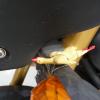Leaderboard
Popular Content
Showing content with the highest reputation on 03/29/2021 in all areas
-
Well, I was talking to myself on my ride today, trying to ride the Stelvio like a sport bike on my 200 miles loop to Borrego Springs. On the way home, I balanced out the 3 cases with a 10 pound bag of oranges in each, along with avocados, tangerines, onions, ginger, and cinnamon. I love the fruit and veggie stands out in Pauma Valley. Perfect spring day in San Diego County - hot in the desert, there was still some snow on top of Mount Palomar, and ocean breezes at home. Another thing I like about the Stelvio - 8 gallon tank. If I had left with it full, I could have done that loop easily without stopping for fuel.4 points
-
Simple enough, then! Back in with fuse and do the voltage check that Lucky Phil posted at about 2500 rpm looking for 13.8-14.2 volts. FWIW, I always disconnect my regulator from the battery when charging. As I recall, EME (where I get my regulators) emphasizes this procedure.3 points
-
Apart from the 30A charging fuse and fuse-holder that you have been advised to check, the other place to look is the plastic 4-wire connector (two +ve and two black) that the alternator regulator are plugged into that takes the power to the fuses at the rear of the bike. Mine is cable-tied onto the front frame just inside and at the front-left of the fuel tank. Because it is 4x 15A/connection, it isn't of the sealed AMP type but a less sealed connector, and, as a result, can get wet and corroded if it isn't well protected by Vaseline or anti-corrosion grease. Having parallel connectors and wires is also a fundamentally poor bit of electrical design since if any one connector goes high resistance, all 30 A can go through one 15A wire, overheat it, and potentially damage other wires in the wiring loom.2 points
-
You start with getting the engine running and putting a multi-meter on the battery terminals and seeing if you get around 13.8 to 14.2 volts when the engine is revved to say 2500 rpm. Ciao2 points
-
1 point
-
Well, that's a relief. I didn't realize it came from a forum guy.. no offense intended.1 point
-
Thank you Paul for weighing in! That's a big relief. I also found about 10 30 amp fuses in the tail cubby hole. I guess this is why I was having charging issues. I'll put one in and check the charging readings. I also should charge the Odyssey again using my 10amp charger.1 point
-
Reading between the lines.. I was blowing the 30 amp fuse, didn't know what to do after blowing through the money of buying a new alternator and regulator, and pulled the fuse. That's my guess, anyway. Not to worry, you are in the right place to get it sorted.1 point
-
If I can find the right link I’ll post it...! 👍😂 🍻 The courage to go further”, the whole Moto Guzzi story On Monday 15 March, on the exact day that the Moto Guzzi blows out its 100 candles, the Automotoclub Storico Italiano presents the preview of the documentary film entitled "The courage to go beyond". An independent project conceived by enthusiasts Massimo Zavaglia and Bruno Nava, produced by Alboran and sponsored by the Municipality of Milan. “The courage to go beyond” (written by Laura Motta and directed by Maurizio Pavone) is the story of the life of the three men who gave rise to the myth of Moto Guzzi: Giorgio Parodi, Carlo Guzzi and Giovanni Ravelli. It is the story of a fraternal bond from which, in the difficult years of the first post-war period, was born a project that became a successful entrepreneurial reality, which wrote important pages in Italian and world motorcycle history. Moto Guzzi is not just a brand that identifies beautiful, fast, technically avant-garde motorcycles and protagonists of memorable sporting victories. It is the expression of the human and professional history of those who made it possible to achieve a goal common to the men who have associated their name with that of the Mandello del Lario company.1 point
-
1 point
-
Thank you so much that makes way more sense I was only missing swingarm tab the other two were there. Again thanks1 point
-
Yupper. A bad battery wouldn't interfere with the reading correct1 point
-
I wouldn't recommend that for a few reasons. Firstly it will make dressing out the damage more difficult but more importantly it makes it impossible to wrap the perforated tube with woven glass/cloth which you need to do when re packing. It's not a good idea to just stuff glass wool down the can without the woven glass around the perforated section because the wool will blow out faster and the tiny loose wool fibres get sucked back into the cylinder on the overrun at the right revs. Not that it's going to do any real damage but best to avaoid that. Ciao1 point
-
1 point
-
1 point
-
Aircraft use circuit breakers so they can be reset after a momentary overload. For instance: https://www.aircraftspruce.com/catalog/elpages/pbcircuitbrkr.php?clickkey=726571 point
-
You see, that is Luigi's plan. If he doesn't grease the steering head bearings, everything on the front end is grounded through them.1 point
-
I like DeOxit gold. I think they call it gold because of the price. It only costs a little more to go first class, though. Probably overkill for a Guzzi. Just the same, I've fixed a ton of electrical problems with it. The Kid fixed a $5000 relay on a helicopter.. So many times, it's just a little corrosion and DeOxit cleans it up and keeps it clean for a year or so. Oh. Doesn't affect plastic like a lot of contact cleaners. I could sell the stuff..1 point
-
If the regulator is not perfectly electrically connected to the negative ground of the bike, then there can be electrical resistance in the connection. Resistance can be caused by rust in steel, oxide on aluminium, tarnish on copper. Age, vibration, and weather make electrical connections develop resistance. In a 12 volt system, resistance matters a lot. Imagine your regulator is rectifying the AC voltage coming in from the alternator, and regulating the output voltage to say 14 V, and outputting 20 amps to the bike & battery. Now add 0.1 ohms of resistance between the regulator body and the battery negative terminal. That is a tiny resistance, but it makes a difference. Ohms law says E=IxR. Voltage = amps (current) times ohms (resistance) 0.1 ohms x 20 amps means the regulator ground is 2 volts above ground. The regulator is happily putting out 14 volts, but the positive lead is now at 16 volts relative to the true ground. Imagine what would happen if there was even higher resistance to ground. Diodes fry, fuses & wires melt, battery gets hot. It is possible that voltage regulators get replaced when the problem is poor grounding. Just bolting in a new regulator can disturb the corrosion underneath to get a better ground, for a while. I believe that mechanical scraping, wire brushing, rubbing with scotchbrite, then assembling with grease is the best way to make good connections. The metal faces of connections must be oxide free (shiny), and I suspect that most electrical cleaning sprays are not active enough to do the job properly. Very few multimeters can detect resistance below 0.5 ohms, so you just have to do the tedious chore of disassembly and mechanical cleaning as a 100,000 km maintenance task.1 point
-
For the ground I crimped a lug on both ends of about 6" of #12, Later on I thought that's not very smart Aluminum to Copper why not just take a piece of Aluminum sheet metal and make a strap from the alloy regulator to the alloy engine case it would hold it's shape better than a wire but add grease as well. I think all the VIIs have a black wire all the way from the regulator to battery negative, it just has too much resistance. It's also been responsible for smoking up several bikes when the main ground has worked loose, the starter current can't get back through the regular cable so it finds it's way back through this regulator ground which gets red hot and melts itself to the rest of the loom. I cannot stress enough the importance of cleaning the battery terminals and adding Vaseline to them, I have seen where a battery becomes completely disconnected although bolted tight by Lead Oxide creeping in between the lug and post, one application of Vaseline will protect the connection for years. Re Maxi Fuse connection. As you can see the fuses aren't blowing, it's just a high resistance that causes heating, Might I suggest drilling a couple of holes in the blade and bolting the wires to it. I would be very cautious about doing away with the fuse, the battery can easily melt any wire on the bike if you get a short I think the Ducati Energia series type regulator might be partially to blame for the heating, once it decides the battery needs to be topped up it effectively connects the alternator directly to the battery delivering as much current as the alternator can produce as, I haven't measured the current pulses but I suspect it may be as high as 40 Amps, its a short duration of high current probably exceeding the rating of the fuse clip. This is another reason to keep your battery terminals in good shape, as you know the alternator Voltage can go to 90 Volts open circuit, you don't want that getting into the ECU if the battery disconnects. Our Guzzi regulators are series type that break the alternator circuit, Most other bikes use shunt regulators that short out the alternator,1 point
-
Kiwi_Roy has told us about the importance of good grounding. Grounding the regulator to it's mount, the mount to the engine, the gearbox to the battery, all should be shiny metal to metal connections assembled with a grease such as vaseline or similar to keep out moisture and oxygen. I think he is right. If the regulator ground voltage is above battery ground, then the regulator output voltage could go high, meaning higher current output, resulting in heating at any high resistance connection (like a tarnished fuse holder).1 point












